Climbing hydrangea is misunderstood. It has a reputation as a temperamental thug, one that takes too long to grow and then grows too much when it does. But have faith friends, Hydrangea anomala petiolaris is a victim of hasty judgement.
It is true that it can take a bit to get going—three to five years in many cases. For this reason it is best to plant it, water it to get established (it’s a hydrangea so it will appreciate the water), and then forget it. Just go about your life in the garden, and one day you will think, “Hey, I wonder how that climbing hydrangea is doing?” And you’ll look at and it will be attached to whatever you’re growing it up and have put on a bit of new growth.
And then you just need to stand back. Because as slow as it is to establish, once it gets going, it goes. And goes. And goes. In fact it can grow to 30 to 50 feet.
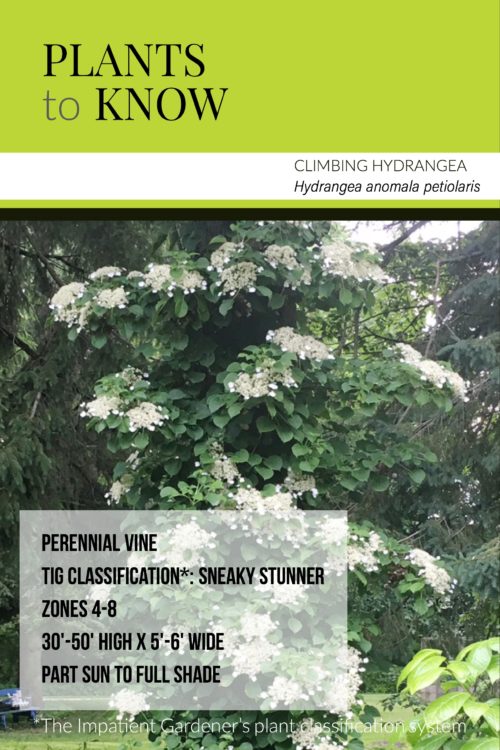
Unlike other vines that either grab on with tendrils or need to be affixed to a structure, climbing hydrangea attaches with aerial rootlets on its stems. These will attach to a tree, siding, bricks, a fence or almost any other non-metallic surface.
Don’t be afraid of this habit. A gardening friend told me about her dismay about how a climbing hydrangea had been destroyed when new owners moved in to a house next door. They wanted to paint the house and ripped out the vines to do it. What she pointed out was that they could have peeled back the vines, painted and then guided them back to the house, temporarily attaching them until new aerial rootlets took over.
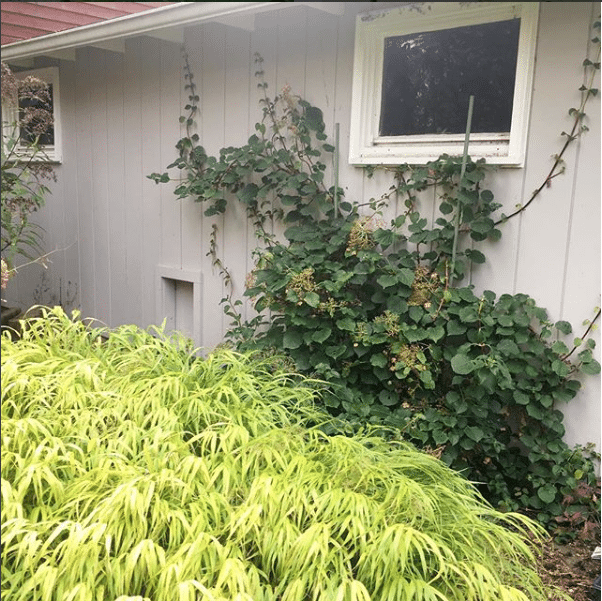
It’s worth keeping the size and attachment method in mind when choosing a spot for this vine. Don’t expect it to respect a pretty 4- by 6-foot trellis because it will eat that for lunch. But this is where it shines: If you need to cover a large area, this vine will do it. And best yet, it will do it where few other plants will.
That’s because climbing hydrangea thrives in part to even full shade. The list of vines that will do that is short indeed. In cooler zones it can handle a good amount of sun as well, so long as it has moisture rich but good draining soil.
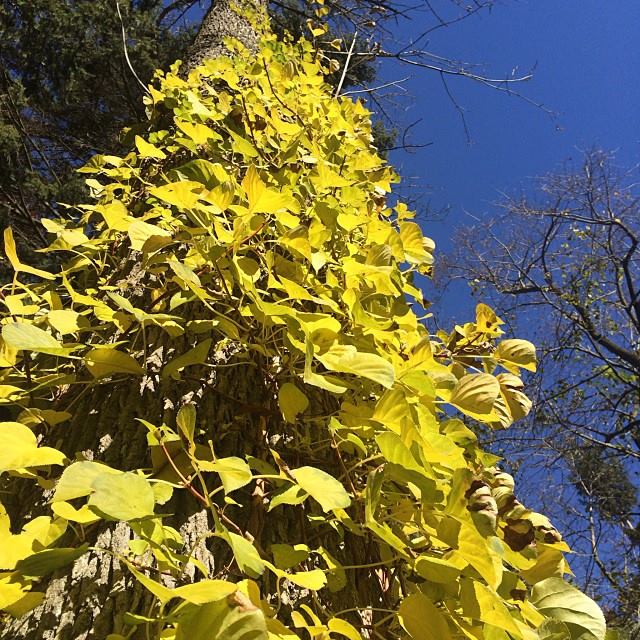
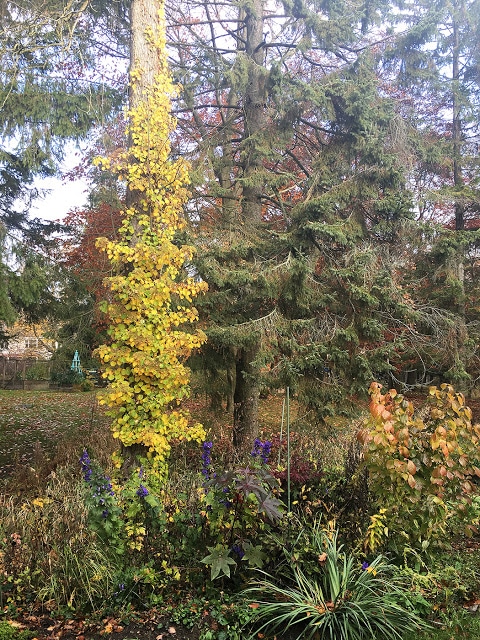
I consider it a four-season plant. In spring its rounded leaves emerge bright green and glossy. In summer, lace cap flowers steal the show. In autumn it turns a brilliant yellow, and in winter its exfoliating bark and spent flowerheads provide texture in a flat landscape.
Because it is slow to establish, it can be an expensive plant, but it’s worth spending more for a larger plant. You’re buying time.
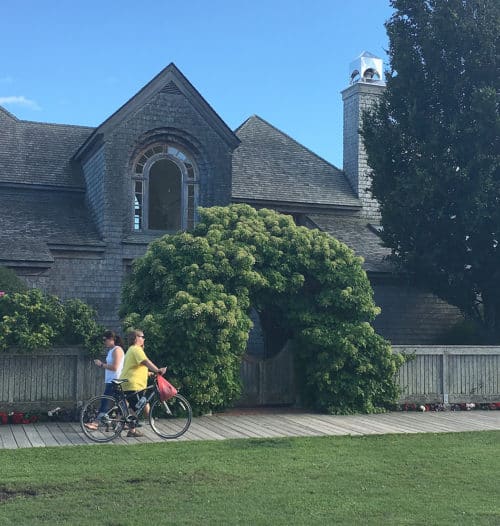
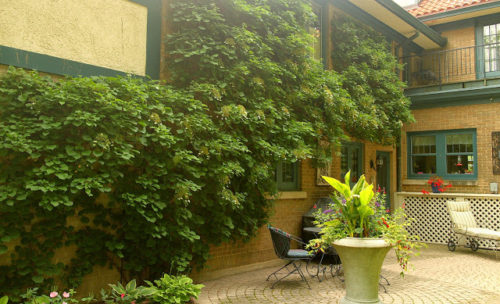
I have two climbing hydrangeas: One on an ash that will surely succumb to emerald ash borer damage soon and another growing on the north side of the garage that I hope will entirely cover that side. My plan for the ash tree, when the time comes, is to top it a bit above the vine’s growth, which is probably at 30 feet or so (well above the second story window I look at it from).
I consider both of them to be real features in the garden, but the kind that you don’t notice right away. And then, when you do, you realize just how great they are.

42 Responses
Our climbing hydrangea has sawdust coming from it somewhere no evidence of ants or other insects. What do you think you could be?
I have a climbing hydrangea that is over 25 years old… trunk is 4″ diameter.
How likely is it that the roots might be as deep as 9ft or 10ft?? I would have thought not nearly that deep -enough to get into my sewer pipe.
The sewer line which is at least 9ft ..possibly 10ft below grade.
I suspected the maple tree but the roto rooter guy says the roots were outside the drip line of the only tree it could be… so HOW deep do we expect a climbing hydrangea to be??
Is mine the only one in the world that’s killing the tree it’s climbing on? It’s huge and gorgeous, full of blooms, but the maple tree is dying.
My guess is that your maple tree has something else going on. I’ve not known climbing hydrangeas to damage otherwise healthy, mature trees.
I have a 3 year year old climbing hydrangea that I have planted beside a brick garage. It has not attached to the side of the garage. I have tried to put wire to help it affix, but it still just falls over the trellis. Any suggestions on how to get it to seater growing on the side ?
We had the same problem. We held the hydrangea up against the wall and put a ladder against it for a couple of weeks. It soon grew new roots which attached to the wall further up.
I need my wood siding painted, and it will be early/mid October. One wall has climbing hydrangea. I am reading that I can peel it off then re-support it, but it’s really huge, how would I go about doing that? I love the look and would rather skip painting the wall, which I realize is not a wise choice. I’m in northern Illinois, and the plant was very small when I moved into the house in 2012.
Thanks for your input.
I used a staple gun that uses round staples. It worked perfectly.
What size wood would you recommend for a trellis? Do you think 2×3″ is sufficient? (Will be using cedar, redwood or cypress.) I’m growing a climbing hydrangea under a deck (56″ high and 20 feet long), so am looking to grow it horizontally, rather than vertically … hence the need for a custom-size trellis. Thanks!
I planted 6 climbing hydrangea along my fence and made a cross cross pattern with with aluminum, unfortunately. Since I have coaxed and tied the sprawling growth they are growing but now worried it’s temporary given your advice. What can I do? I was thinking about wrapping the aluminum in butcher twine?
What if any pruning do you recommend? Ours is looking a bit leggy and hasn’t flowered well this year.
My question is about how much you can keep this plant in check. I live in Maryland and am looking to plant this in a completely shaded spot to climb on an existing fence (about 10 feet long by 8 feet high). Will I be able to keep the plant pruned to generally stay on this fence, or should I just look for something else? Would love to find a pretty flowering climbing plant that will be OK with full shade. Thanks!
I lived in Bethesda. I had an 8’ fence. After a few years it was fantastic. I pruned the underside to show the bark climbing in the winter after it dropped its leaves. I pruned a bit on top to keep it the height of the fence. It was a north facing fence and it was fabulous. At created its own canopy. Easy plant. Doesn’t need much. Wish I had a spot for it here in MA. Good luck.
Will this climbing hydrangea grow under a pine tree?
I have a client who is having a new fence installed behind her climbing hydrangea. It is currently about 25’-30’. I will be building a temporary structure structure underneath to support it during the process. I also plan on a shot of liquid fertilizer and some slow release as well at the base of the trunk to beef up its recovery process over the next month or so before the new fence goes in.
Sadly, last winter there was damage and we lost half of the vine to snow damage. I tried rooting some of the broken vine, but as this is not a “full time” customer due to the property size (extremely small city lot without external access to courtyard area), I have no idea how the cuttings performed…yet.
Do you have any advice for the temporary structure?
You mentioned not on metal… I have an aluminum (faux iron) fence that I’d love to have a vining flower to make the far end of the property look appealing. Thoughts?
I’m interested in an answer to this question, too. Wonder why metal is not recommended/why it wouldn’t work.
Because climbing hydrangeas “climb” via aerial roots, they need a surface they can “dig” into a little. It’s not like clematis that climbs with tendrils. Smooth metal doesn’t really have much to grab onto. Some vines are also resistant to climbing on metal because of heat. Some plants are also resistant to some metals (typically copper), although likely does not apply in this situation.
I’ve had one for 10 years growing up a trellis on the north side of my house. The plant has never flowered I feed it with holly tone and still no flowers. What can I do to get it to flower?
I’ve heard that, although climbing hydrangea CAN grow on a shady North Wall, it won’t flower there.
Mine flowered on a north facing fence after about three years. It was fabulous.
My wife has reservations about planting this on a shady flat wall on the side of our house – Hardie Plank surface. Should we be concerned it will overtake and hurt the house in some way?
We are zone 5a, 53821, but the last winter seems to have taken out everything above the snow cover line on our climbing hydrangea; the lowest foot is lush green and beautiful, but above that is brown and looks dead. We are waiting a week or so more to see if any of the damaged parts have survived. However, most likely it will be a major trim job.
Hi Erin, I just bought one of these. Arrived last week. Given our weather (I’m in a shore community near Milwaukee along the lake), I’m wondering if I could plant it now – or should I wait a bit deeper into May?
You can definitely plant this now. Enjoy!
any chance of success planting in very large planter?
I think anything can be planted in a container. The only issue is the hardiness. The rule of thumb for overwintering something in a container is that it should be two zones hardier than the zone you’re in. You can do some things to help, like stacking straw bales around the container or mulching the top really, really well, but it is a bit risky. If you can manage the hardiness thing I’d say you’d be fine with it in a container, although I would do a fairly rich potting mix and fertilize regularly.
How much sun can a climbing Hydrangea tolerate? I have just removed an established one from a trellised area, trellis is still attached, want to plant in garden bed that will get East, Late West sun, not sure if that’s too much sun, hubby doesn’t want against house. I have rich loamy soil, perennials around the area, Filbert shrubs on one side, Royal Star Magnolia on other side? Not sure about it’s exposure to too much sun. I have limited space on North side of house and no planting bed on East side of house.
I’ve got a pretty big one attached to the side of our house and we’re going to have our wood siding replaced with Hardie. Any recommendations for how to safely remove it from the wall? Is it okay to trim it back a bit at this time of year? It’s well established—we’ve lived here for 7 years and it was here when we moved in. Thanks!!
Can it be very slow to get started in the spring. There do not seem to be any buds but there are some brownish shoots.
I’m wondering if this is what I have. It doesn’t exactly get flowers but “clusters” that resemble elderberry blossoms. I just found your blog. Thank you from another zone 5er.
I recently removed my 28 year old plant because it was a focal point and the Japanese beetles kept decimating it. Very sad. I’ll plant a new one in the north side of my garage and see what happens there.
If you’re not opposed to insecticides then get some Bayer 3 in 1 granules and start applying in May. It will solve your beetle problem.
I had one for several years. I kept moving it around in the garden. Not a good thing to do. When it finally go established it grew up a trellis and flowered so beautifully. Then we had one too many droughts in a row and despite my watering it died. It was such a disappointment. I have again attempted growing this beauty. I too have planted one at the base of our Ash tree. It seemed happy last summer I can’t wait to see it start inching up the tree trunk.
Those two plants are gorgeous and yours is beginning to be impressive. And, yes, I recognized my neighbors.
And I’ve seen a picture of it growing on a black walnut so I’ve planted it in a garden with two black walnuts. It’s the first thing I planted because I read that it was slow to establish. This will be its third year so I’m hoping for some significant growth.
Hi, I planted one at the base of a 100 year old mighty oak here north of Boston. It did take two to three years to establish itself but now, 10 years on, it has grown 75 feet up the trunk and looks just beautiful. Well worth the wait!
This is precisely the information I’m looking for. Is it thriving near the black walnuts? I would like to plant a climbing hydrangea and would love to know. Any tips appreciated. Thanks!
The whole black walnut thing is a bit overblown, to be honest, but that’s a topic for another time. I have found reports of climbing hydrangea doing well near black walnuts however. If you’re interested in digging into the history of the black walnut effect (and it’s quite fascinating, believe it or not) here’s a place to start with a link to an excellent study on it: https://extension.umd.edu/hgic/topics/walnut-toxicity-juglone
I also would like to plant near a Black Walnut – feedback?